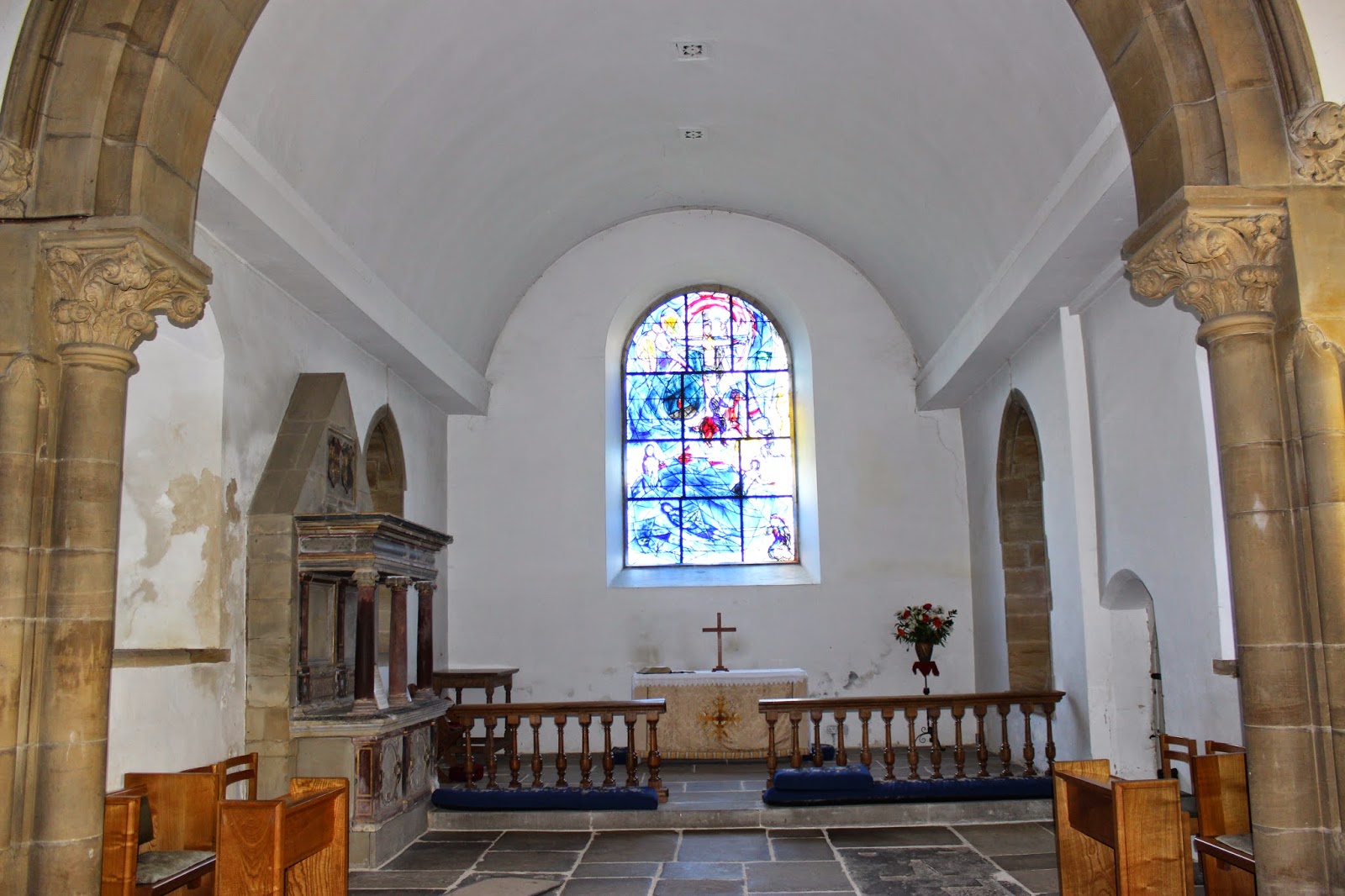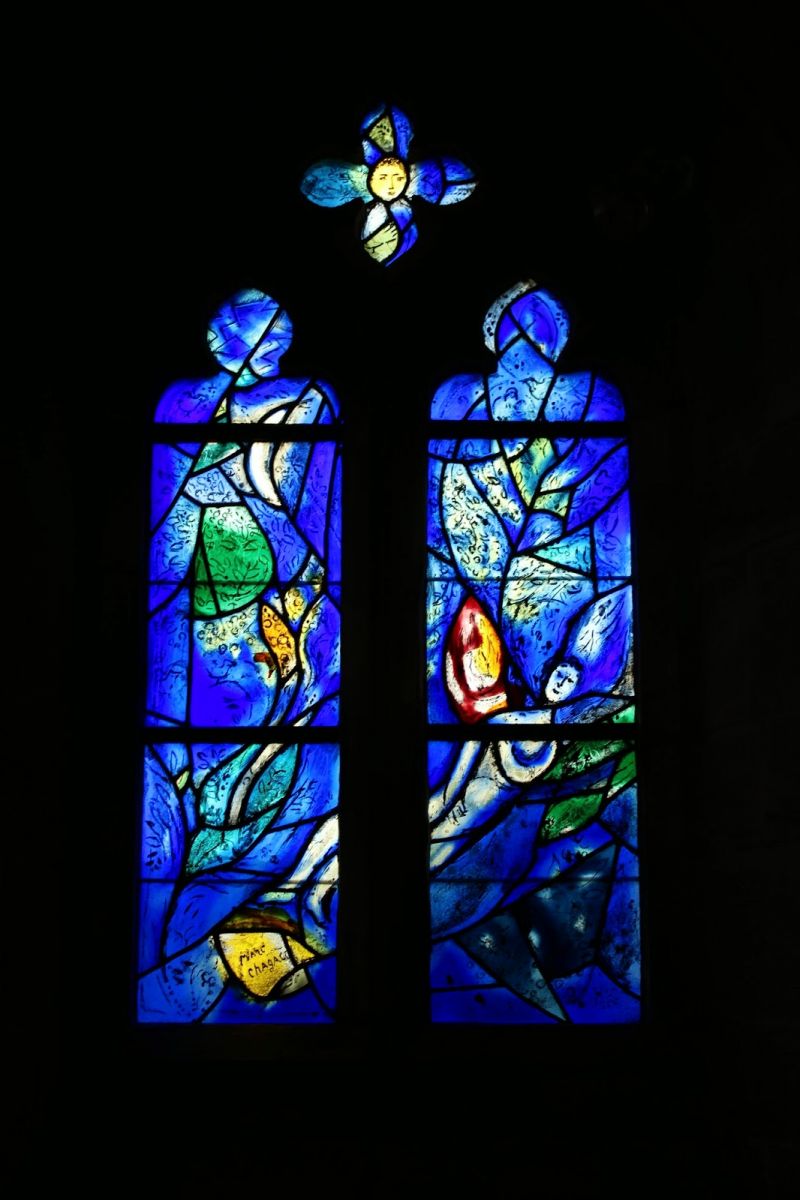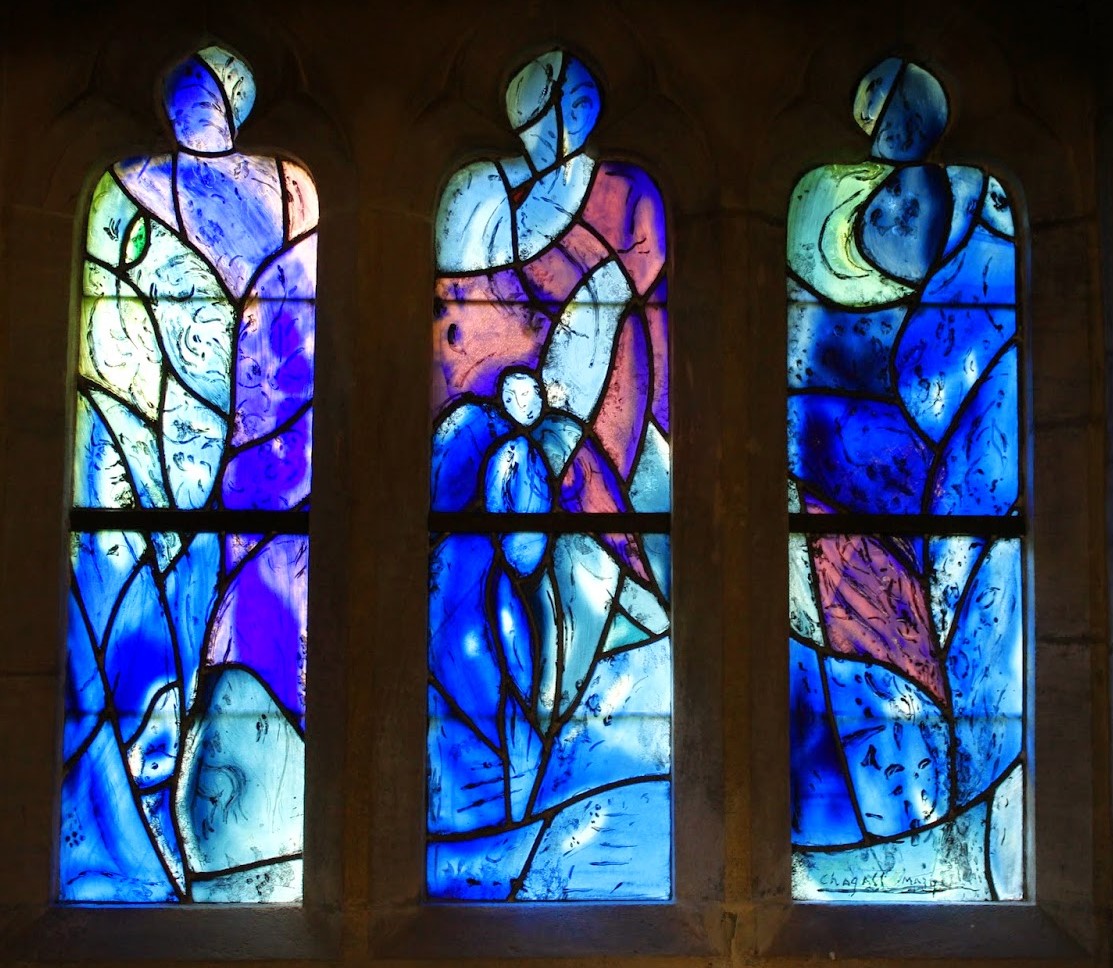England: All Saints Parish Church, Tudeley
All Saints Parish Church, Tudeley
by Jonathan Evens
Hidden away at the end of a lane leading from Five Oaks Green Road, set among fields and Kentish Oast houses in the Tunbridge Wells borough of Kent, England), is a pretty, compact country church which dates to the beginning of the seventh century, although most of what can be seen today is from the 18th century.
The brick tower and marbled ceiling of All Saints’ Tudeley date from around 1765, while the North aisle was added in 1871. The interior was substantially re-ordered in 1966, creating a greater sense of space and light. It was what came next, however, that created a wow factor; something that is astonishing both in its physical impact and in the uniqueness of its nature.
On my sabbatical pilgrimage I’ve arrived at a church which is one of the UK’s finest examples of religious art and a moving example of the crucifixion as a conduit for a very personal tragedy. As I walk into Tudeley Parish Church I am immediately immersed in intense colours – ‘rich and deep marine blue, with blends of burgundy and bottle green’ – because, as James Crockford has described, every window in the church ‘from great big panes of light to tiny peep holes’ was designed by the Russian-Jewish artist Marc Chagall. Chagall’s designs swirl with emotive colour and evocative movement. This is stained-glass that shines and glows ‘with a glory that hits you’ through ‘the energy of light and life that bursts or glows through.’[i]
These windows were installed between 1967 and 1985; the east window being followed by the five north windows and two south ones dedicated in 1974 and then finally the four chancel windows installed in 1985. Chagall was initially reluctant to take on the commission, but was eventually persuaded and when, in 1967, he arrived for the installation of the east window and saw the church, he said, 'It's magnificent. I will do them all.' Over the next 15 years, he designed all the remaining eleven windows, collaborating as usual with glassworker Charles Marq of Reims.
This sustained series of stained glass was inspired by Psalm 8, especially verses 4-8:
What is man that you are mindful of him, the son of man that you care for him? You made him a little lower than the heavenly beings and crowned him with glory and honour. You made him ruler over the works of your hands; you put everything under his feet: all flocks and herds, and the beasts of the field, the birds of the air, and the fish of the sea, all that swim the paths of the seas.
There’s a dilemma on entering as the East window draws your attention but the surrounding windows lead up to it. That’s where the flocks and herds, beasts, birds and fish of creation from the Psalm are to be found, so do you begin with the culminating experience – the east window with its depiction of crucifixion and drowning – or the preparatory experience of the Psalm inspired windows? Wherever you begin a sustained viewing of this series, which sets death in the context of creation while brightly bathing the building in vibrant colour, is to have an experience of profound spirituality.
The east window is a magnificent memorial tribute to Sarah d'Avigdor-Goldsmid who died aged just 21 in a sailing accident off Rye. Sarah was the daughter of Sir Henry and Lady d'Avigdor-Goldsmid; the family then lived at Somerhill, a Jacobean house situated nearby. As Sarah had shown an early interest in contemporary art and had with her mother seen Chagall’s designs for windows in the synagogue of the Hadassah Medical Centre in Jerusalem, Sir Henry and Lady d'Avigdor-Goldsmid commissioned Chagall to design the east window.
Crockford has reflected on what Chagall offers to us through sustained viewing of this visionary series: ‘What I think Chagall offers us so well is a vision that holds together the devastation of a painful tragedy with a vision of hope and renewal. He suggests the real possibility of the transformation of human loss, a loss that seems pretty integral to humanness; yet there is no glimmer of forgetting or diminishing the gravity and depth of that suffering. We see here an invitation to let our suffering be a sharing in his [Christ’s] sufferings, a way of becoming like him, just as, in suffering, he becomes like us. The stories of our lives are drawn up into the reality of Christ: that includes our death and our life, our fear and our freedom, our shame and our glory.’[ii]
He has also described well the experience of surrender required in relation to the experience of Tudeley Parish Church:
‘There’s an overwhelming experience, as you cross the threshold, of having entered a different sort of space. You feel immersed, surrounded, swallowed, which … is a significant part of the effect. The windows have a way of surrounding you and won’t let you go. They weigh heavily on the space. And that’s not simply a weight of colour and design. There’s far more to these windows, as always with Chagall; a density of symbolism and encounter.
What has, for years, spoken to me, and stayed with me, about this scene of Chagall’s, is not the detail of what it all might convey in its parts or its whole, but rather the experience of sitting in that still, small church, immersed in the colour and pain and hope of those windows shining through.’[iii]
Tudeley’s remoteness necessitates giving time to visit and Chagall’s art rewards slowing down to look and linger, to sustain our looking in order that we truly see.
*******
Jonathan Evens is Associate Vicar, Partnership Development at St Martin-in-the-Fields, London, England. A keen blogger, he posts regularly on issues of faith and culture at http://joninbetween.blogspot.co.uk. His journalism and art criticism ranges from Pugin to U2 and has appeared in a range of publications, including Artlyst and Church Times. He runs a visual arts organisation called commission4mission, which encourages churches to commission contemporary art and, together with the artist Henry Shelton, has published two collections of meditations and images on Christ's Passion. Together with the musician Peter Banks, he has published a book on faith and music entitled ‘The Secret Chord’.
Notes:
[i] J. Crockford, ‘Chagall at Tudeley’, Sermon preached at University Church, Oxford, 7th April 2019 - https://www.universitychurch.ox.ac.uk/sermons/chagall-tudeley?fbclid=IwAR3hxj1Lah8A5Uq2yYjggxw1rafwJlxq-4V86olsvwSdpyoLAJ11kKNvKAc
[ii] Ibid.
[iii] Ibid.
For more Church of the Month discussions of churches, see http://www.artway.eu/content.php?id=21&lang=en






